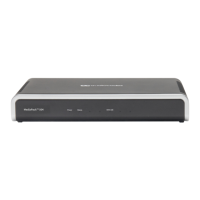Version 6.2 263 February 2011
SIP User's Manual 8. IP Telephony Capabilities
ETSICallerIDTypeOneSubStandard
Enable or disable (per port) the caller ID generation (for FXS) and detection (for FXO)
using the ‘Generate / Detect Caller ID to Tel’ table (EnableCallerID). If a port isn’t
configured, its caller ID generation / detection are determined according to the global
parameter EnableCallerID.
EnableCallerIDTypeTwo: disables / enables the generation of Caller ID type 2 when
the phone is off-hooked (used for call waiting).
RingsBeforeCallerID: sets the number of rings before the device starts detection of
caller ID (FXO only). By default, the device detects the caller ID signal between the
first and second rings.
AnalogCallerIDTimimgMode: determines the time period when a caller ID signal is
generated (FXS only). By default, the caller ID is generated between the first two
rings.
PolarityReversalType: some Caller ID signals use reversal polarity and/or wink
signals. In these scenarios, it is recommended to set PolarityReversalType to 1 (Hard)
(FXS only).
The Caller ID interworking can be changed using the parameters
UseSourceNumberAsDisplayName and UseDisplayNameAsSourceNumber.
8.2.7.8.2 Debugging a Caller ID Detection on FXO
The procedure below describes debugging caller ID detection in FXO interfaces.
¾ To debug a Caller ID detection on an FXO interface:
1. Verify that the parameter EnableCallerID is set to 1.
2. Verify that the caller ID standard (and substandard) of the device matches the
standard of the PBX (using the parameters CallerIDType,
BellcoreCallerIDTypeOneSubStandard, and ETSICallerIDTypeOneSubStandard).
3. Define the number of rings before the device starts the detection of caller ID (using the
parameter RingsBeforeCallerID).
4. Verify that the correct FXO coefficient type is selected (using the parameter
CountryCoefficients), as the device is unable to recognize caller ID signals that are
distorted.
5. Connect a phone to the analog line of the PBX (instead of to the device's FXO
interface) and verify that it displays the caller ID.
If the above does not solve the problem, you need to record the caller ID signal (and send
it to AudioCodes), as described below.
¾ To record the caller ID signal using the debug recording mechanism:
1. Access the FAE page (by appending "FAE" to the device's IP address in the Web
browser's URL, for example, http://10.13.4.13/FAE).
2. Press the Cmd Shell link.
3. Enter the following commands:
dr
ait <IP address of PC to collect the debug traces sent from
the device>
AddChannelIdTrace ALL-WITH-PCM <port number, which starts from
0>
Start
4. Make a call to the FXO.
5. To stop the DR recording, at the CLI prompt, type STOP.

